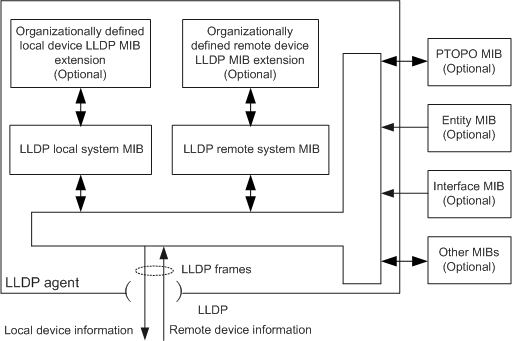LLDP Implementation
LLDP collects and sends local device information to remote devices. The local device saves information received from remote devices to MIBs. Figure 1 shows how LLDP is implemented.
LLDP is implemented as follows:
- The LLDP module uses an LLDP agent to interact with the Physical Topology MIB, Entity MIB, Interfaces MIB, and other MIBs to update the LLDP local system MIB and LLDP local organizationally defined extended MIB.
- The LLDP agent encapsulates local device information into LLDP frames and sends the LLDP frames to remote devices.
- After receiving LLDP frames from remote devices, the LLDP agent updates the LLDP remote system MIB and LLDP remote organizationally defined extended MIB.
- By exchanging LLDP frames with remote devices, the local device can obtain information about remote devices, including remote interfaces connected to the local device and MAC addresses of remote devices.
The LLDP local system MIB stores local device information, including the device ID, port ID, system name, system description, port description, and management address.
The LLDP remote system MIB stores neighbor information, including the device ID, port ID, system name, system description, port description, and management address of each neighbor.
An LLDP agent performs the following tasks:
- Maintains the LLDP local system MIB and LLDP remote system MIB.
- Obtains and sends LLDP local system MIB information to remote devices when the local device status changes. An LLDP agent also obtains and sends LLDP local system MIB information to remote devices at periodic intervals if the local device status does not change.
- Identifies and processes received LLDP frames.
- Sends LLDP traps to the NMS when information in the LLDP local system MIB or LLDP remote system MIB changes.
